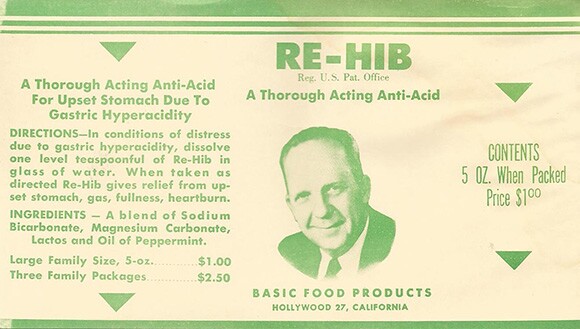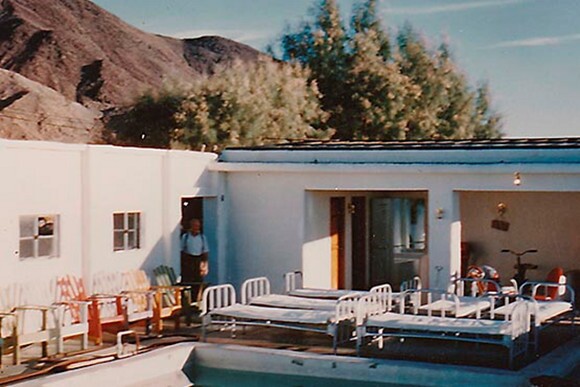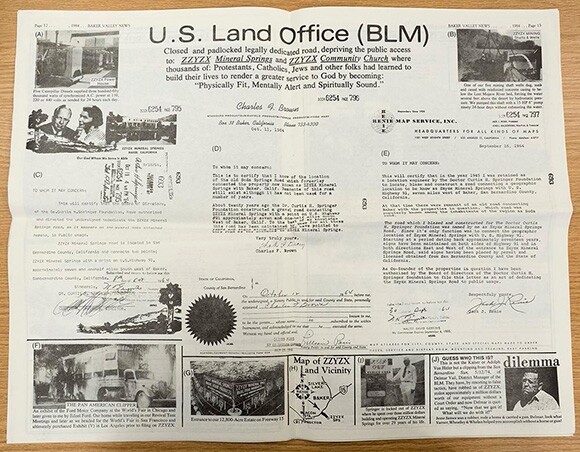Zzyzx: Revisiting Doc Springer's Boulevard of Dreams


The Mojave Project is an experimental transmedia documentary by Kim Stringfellow exploring the physical, geological and cultural landscape of the Mojave Desert. The Mojave Project reconsiders and establishes multiple ways in which to interpret this unique and complex landscape, through association and connection of seemingly unrelated sites, themes, and subjects thus creating a speculative and immersive experience for its audience.
Many iconic points of interest dot the Mojave Desert stretch of Interstate 15, the busy speedway linking Los Angeles and Las Vegas.
The recent ruins of the Rock-A-Hoola Waterpark, also known as Lake Dolores, are prominent from the highway -- 23 miles east of Barstow and 45 miles west of Baker. Once said to have had the world's longest raft ride, its endless rivers have now sat dry for over a decade, slides removed, and concrete channels marvelously vandalized. For years there have been rumors of the park's eventual reopening, but this seems less likely with each new layer of graffiti.
Other points of interest along this stretch of the I-15 have, in fact, closed and reopened, including the World's Largest Thermometer. Rising 134 feet high (the same number as the highest air temperature ever recorded in North America in 1934 in Death Valley) in the town of Baker, it is easy to spot from the interstate, and features a digital readout that displays the outside temperature. It was sold and closed in 2012, but reopened in 2014 with new energy-efficient LEDs and a visitor center.

Taller and brighter than the World's Largest Thermometer is Ivanpah solar power plant, a futuristic landmark near the California/Nevada state line -- a trio of blinding 450-foot-tall towers that rise above 3,500 acres of mirrors mounted on 173,500 heliostats. When the array went online in early 2014, it was likely the largest solar power plant in the world -- certainly the largest thermal solar power plant.
Other notable sites along I-15 are not immediately visible from the highway, but still manage to become roadside attractions. The sign for the Zzyzx Road highway exit is itself an icon of the interstate, one that has inspired or lent its name to at least two horror movies, a literary journal, a band, several songs, a fictional company in a television series, and a contemporary art exhibit. To many travelers, Zzyzx is nothing more than mysterious signage of uncertain pronunciation -- a strange and curious marker of the middle of nowhere.
However, those who take the Zzyzx off-ramp and drive the four and a half miles to the end of the dirt road are treated to an unexpected oasis with perhaps an even more surprising history. Lush palms, pools, and several concrete structures comprise the sprawling Zzyzx compound, also known as Soda Springs, at the western edge of Soda Dry Lake. This desert retreat was the vision of Curtis Howe Springer, who operated Zzyzx Mineral Springs and Health Resort for 30 years, from 1944 to 1974.

Springer -- a radio evangelist and proponent of homeopathic health aides who hosted syndicated programs broadcast to over 200 radio stations in the United States and over 100 overseas at their peak -- referred to himself as a "a salesman... a Methodist preacher, vitamin salesman and resort owner."1 The serialized radio show emphasized the importance of following the Christian doctrine to become physically fit, mentally alert, and spiritually sound. Central to this was the belief in the healing property of foods. A healthy diet was essential to becoming "internally, externally, and eternally clean."2
By 1928, Springer had embarked on his own line of health products, which he sold over the radio and through mail orders. These homeopathic concoctions included the Antediluvian Desert Herb Tea (described as a botanical laxative of herbs, roots and barks), Acidine ("nature's normalizer for acid stomachs"), Hollywood Pep Cocktail (which contained "concentrated vital food energy" and was to be sprinkled over foods), Manna ("a blend of ten different fruits and vegetables"), O-M-R ("one minute relief for indigestion"), RE-HIB ("a thorough acting anti-acid") and Zy-Crystals (a combination of Epsom salts and salt harvested from Soda Dry Lake; to be topically applied to the scalp while holding one's breath). Despite their colorful names, a breakdown of the active ingredients in these products suggest that they are not so different from the homeopathic treatments many choose to use today.
By the early 1940s, Springer had moved to Los Angeles to retire. However, he ended up expanding his health endeavors to include free public lectures, held twice a day at downtown Los Angeles hotels such as the Alexandria Hotel. Previously, he had helped establish health institutions in six states, and after stumbling upon a book about the mineral springs of the Pacific Coast, he decided to seek out a California retreat center dedicated to healthy living. The book mentioned Fort Soda Springs, a remote site 200 miles east of Los Angeles and 11 miles southwest of Baker, composed of a long-abandoned railroad station and Army post.
He visited the site, and found that its remote location, access to water, and plentiful sunshine made it an ideal site for a retreat center. On September 13, 1944, Springer filed for mining claims on 12,800 acres of land for what was to be Zzyzx Mineral Springs and Health Resort -- named Zzyzx (pronounced "zi-zex") to be "the last word" in medicine -- with the understanding that after five years of mining activity he would have the option to purchase the land.
On the 13th day of September 1944, my wife, my father, Jack Renie, and I packed food and a camping outfit for a trip into the great Mojave desert in search of Old Fort Soda... we discovered the crumpled remains of the old fort... A beautiful oasis with wild ducks, wild geese, fish in abundance but apparently abandoned by civilization. We camped there that night and the next morning, assuming it was public domain, we did the discovery work and set up monuments of rock in the event we found it was open for filing upon.
We then drove to the County Seat, San Bernardino, and found the property belonged to a relative of ours -- good old Uncle Sam, or the United States Government. Since each person is limited to a certain number of acres to file upon (and there were only four of us in the discovery party) we got busy and interested a number of our friends and relatives to join with us in filing on twelve thousand eight hundred acres of land.
Here was a brand new challenge for me to come out of retirement and go back to work.3
The compound began with several tents, and grew to include numerous developments, including the two-story "Castle" residence, "Zycott" housing and other simple overnight accommodations for over 100 visitors, a dining hall, lecture room, church, library and office (that also functioned as Springer's recording studio), pool house, goat shed, diesel generator, subterranean rabbit chambers (to keep the rabbits cool in extreme heat), and a "Zzyport" runway. For this extensive construction, Springer recruited "helping hands" whom he picked up from Los Angeles' Skid Row and put to work, in exchange for food, shelter and minimal wage.


Once completed, Zzyzx offered visitors a healthy environment. There, folks had a chance to detox and abstain from alcohol, smoking and combative quarreling, and instead bask in sermons and sunshine, and restore with a special diet (largely of foods grown and raised on the property, such as rabbit's meat, goat's milk, and fresh fruits and vegetables), and soak in warm pools of "healing" mineral-rich water (that in actuality was heated water from the Mojave River whose terminus is Soda Lake).4
The retreat center was publicized on Springer's radio program, in newspaper advertisements, and in his newsletter "The Elucidator," and remained a popular destination throughout the 1960s. Springer built a paved road connecting Zzyzx to the highway, where eye-catching signage promoted the retreat center as a roadside attraction where all were welcome. A fleet of buses and an eight-door Chevrolet utility vehicle would also shuttle guests to and from Zzyzx and locations in Los Angeles, such as the Figueroa Hotel, once a week. Springer used a sliding scale to calculate the cost of staying at the resort, though no one was turned away for lack of funds.


The compound could accommodate over 100 overnight guests at a time, and continued to welcome visitors until its closure on April 11, 1974, when Springer was forcibly removed from the site by the Bureau of Land Management (BLM) for unauthorized use of federal land. The court, under Judge Francis C. Whelan, found that the mining claims Springer had filed did not authorize occupation or development of the land beyond mining activities. He was given a mere 36 hours to vacate the compound and salvage any of his belongings that he had amassed over the last 30 or so years.
Although Springer's removal and the retreat center's closure happened abruptly, his eviction had been preceded by years of lengthy legal proceedings, investigations and media scrutiny. A two-page article published in the Los Angeles Times on July 14, 1967, headlined "Squatter Owes Rent, U.S. Says," and reported that "super squatter" Springer was not authorized to use the 12,800 acres of government land for his retreat center, and that the BLM was seeking $34,187 from him in damages and back "rental." Los Angeles Times writer Charles Hillinger, who seemed to have a personal vendetta against Springer, would go on to cover the story for over 20 years, exposing Springer as a "quack," suggesting that he misled his followers into believing he was a bona fide doctor and Methodist minister, when in fact he was not certified as either.5
By November 1968 Springer had been arrested on a warrant charging him with 65 counts of false advertising and misrepresentation, brought on by the California Department of Public Health's Bureau of Food and Drug Inspections. The state's charges were based on the general notion that Springer was peddling foods such as celery, carrots, parsley, and turnips as health-food supplements with unfounded therapeutic claims, as well as selling untested and potentially unsafe treatments, such as a "$25 cure-it-yourself hemorrhoid kit."6 He pleaded guilty on eight counts of violating state business and health codes, for false advertisement and mislabeling of food products.
This was followed by a court order to stop all advertising and activities at Zzyzx, and years of litigation over Springer's right to occupy and develop federal property on the basis of mining claims. Springer maintained that his 1944 mining claims on the land, filed under the General Mining Act of 1872, permitted such development of the surface, arguing that the U.S. Land Office (the predecessor to the BLM) did not stipulate any specific extractive activity or locatable mineral, and that his harvesting of salt crystals for health supplements qualified as mining for an economic mineral. "There was no mention of the mining of gold. We were seeking minerals for both internal and external therapeutic purposes."7 However, government officials found that "Springer did almost everything but mine," and thus had no claim to the property.8
After being evicted, Springer moved to Las Vegas, but did not give up the fight over Zzyzx. He published lengthy print features in the Baker Valley News, whose residents generally supported Springer and his Zzyzx compound. An exhaustive editorial entitled "The Legal Rape of Zzyzx" appeared on October 18, 1984, in which Springer outlined the injustices he had endured. The newspaper article included printed letters of support from local stakeholders, outlining Springer's many contributions to the Baker community at large, including building and maintaining Zzyzx Road, and bringing the town of Baker a post office. Springer's supporters argue that under Springer's reign, the public land actually served the public -- whereas the road to Zzyzx was closed off during its early years under BLM management, preventing public access.

Mojave Desert historian/writer Dennis Casebier (who would later go on to found Friends of the Mojave Road and the Mojave Desert Heritage and Cultural Association), who was a personal friend of the Springer, recalls that upon returning to Zzyzx post-Springer occupation in 1983, he experienced what he called a very "unpublic" feeling at the site. "Missing were the WELCOME signs. In their place a battery of KEEP OUT signs had been erected -- so many that I felt intimidated even though I had business there as lecturer to one of the weekend classes."9
Zzyzx fell into disrepair and lay dormant for a period of time, while the BLM sorted out various ideas of what to do with the site, including the possibility of demolishing Springer's architectural contributions in order to return Soda Springs to its previous state.10 Casebier remarks that the agency actually had bulldozers on site, waiting for the green flag to demolish the complex, and, he believes, in the process deliberately destroy most of Springer's papers and documents detailing his tenure at Zzyzx. The BLM eventually worked out a deal with the California State University system to use the former resort as a desert studies center, and reopen the road.

Today, Zzyzx continues to function as the CSU Desert Studies Center, hosting students and researchers interested in studying desert ecology. While the center's focus has shifted to environmental studies, there are a few displays telling of its Zzyzx Mineral Springs and Health Resort origins, and longtime manager Robert Fulton is enthusiastic to speak of the Springer days.
Springer's visionary spirit is undeniably present -- if you listen closely enough, you just might catch Doc Springer's sermons broadcasting from along the Boulevard of Dreams.
Audio track and video courtesy CSU Desert Studies Center.
Notes:
1 Rasmussen, Cecilia. "Zzyzx: An Unlikely Home of Hucksterism and Miracle Cures." Los Angeles Times. 16 June 2002. Print.
2 Robert, Steven V. "Improbable Name, But... ZZYZX Is A Booming Health Spa." Daytona Beach Sunday News. 19 July 1970. Print.
3 Springer, Curtis H. "One of the Strangest Stories Ever Told." Baker Valley News. 18 October 1984. Print.
4 Hillinger, Charles. "'Squatter' Owes Rent, U.S. Says." Los Angeles Times. 14 July 1967. Print.
5 Hillinger, Charles. The article quotes Springer, admitting he is not a licensed doctor or ordained minister, but rather is self-educated and "basically a salesman... a Methodist preacher, vitamin salesman and resort owner." 14 July 1967.
6 Hillinger, Charles. "Radio Evangelist Seized on Food, Drug Charges." Los Angeles Times. 8 November 1968. Print.
7 Springer, Curtis H. "The Legal Rape of Zzyzx." Baker Valley News. 18 October 1984. Print.
8 "Zzyzx Goes Pffft -- Evangelist Is Evicted From Desert Tract." Los Angeles Times. 12 April 1974. Print.
9 Casebier, Dennis. "Zzyzx: Unrest at the End of the Alphabet." Nevadan [Sunday supplement to the Las Vegas Review] 10 June 1984. Print.
10 From a conversation on January 5, 2015 with Dennis Casebier at the Mojave Desert Heritage and Cultural Association (MDHCA) in Goffs, CA. Casabier conducted extensive interviews with Springer between 1981-1985. These interviews are archived at the MDHCA.
Dig this story? Sign up for our newsletter to get unique arts & culture stories and videos from across Southern California in your inbox. Also, follow Artbound on Facebook, Twitter, and Youtube.
Top Image: A roadside sign pointing the way to Zzyzx | Jason Wallace/CSU Desert Studies Center.


